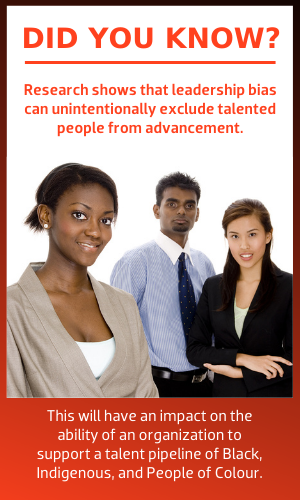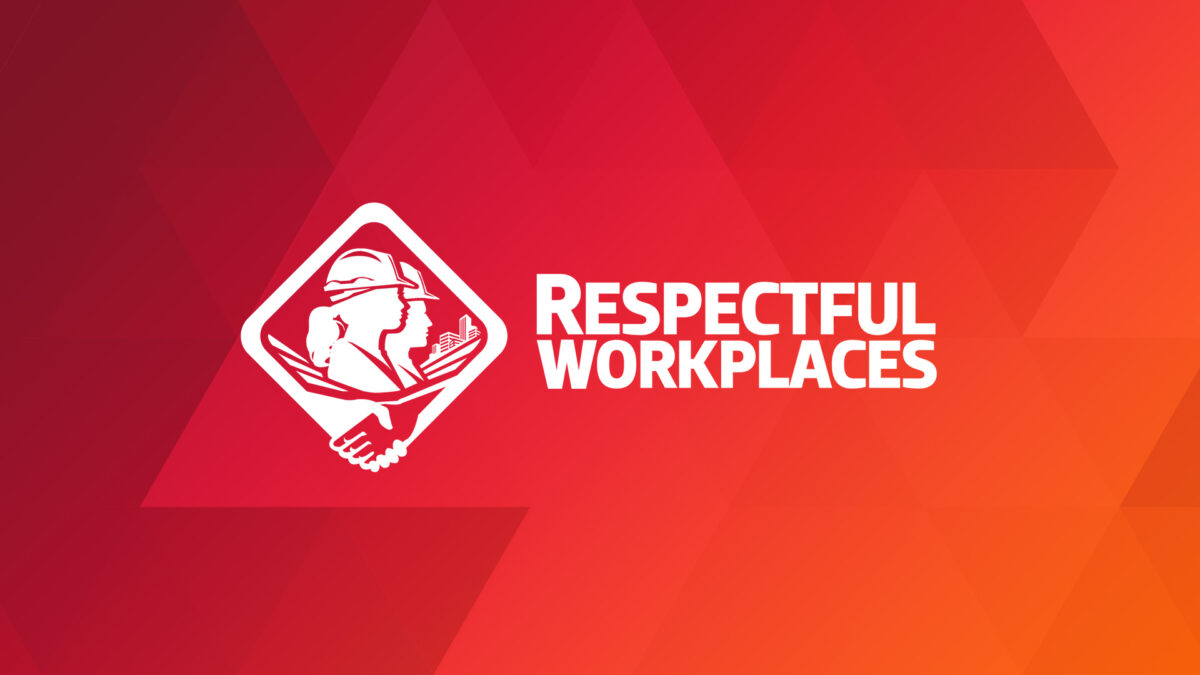Does your organization understand the impact of leadership bias on its talent pipeline?

In the Deloitte “leader-led” model of inclusion, (see Blog #47), the first priority for an organization to become inclusive is to have a leadership team that understands the link between business success and an organization’s ability to recruit, retain, and advance the most skilled and capable workers from all talent pools.
To support the first priority, however, the “leader led” model acknowledges that leaders must be aware of their own biases and the assumptions they are making. Research shows that leaders and managers directly influence the performance of those who are subordinate to them. However, because of unconscious or unintentional bias, leaders and managers can behave in ways that limit the potential of talented individuals. This will have an impact on the ability of an organization to support a talent pipeline of Black, Indigenous, and People of Colour.
How bias influences job performance
1. Bias and stereotypes influence the decisions and behaviour of leaders and managers.
Readers may remember that bias and stereotypes are reinforced automatically by our unconscious mind (see Blog #46). For example, priming bias occurs when we are “primed” to think more highly of a person when we know that a trusted colleague thinks highly of that person. This may lead a manager to be more available and grant attention to specific individuals based on the reports of others rather than on an independent assessment of the candidate’s suitability for promotion or good job assignments.
Research has shown that access to key decision makers is associated with more promotions and high-profile job assignments. Yet Black professionals report having less access to key decision makers than their white colleagues. In a study of Black professionals, researchers asked participants if they felt they had access to senior leaders at work. The study found that 31% of Black professionals said they have access to senior leaders at work compared to 44% of white professionals.
This finding is even more significant when compared to the finding that Black professionals are more likely than their white colleagues to be ambitious in their careers and to aspire to a top job (65% of Black professionals compared to 53% of white professionals).
2. Bias and stereotypes create expectations, and a leader’s expectations have a direct impact on the performance of those subordinate to them.
How?
Unconscious bias often results in a set of micro-behaviours: the small, and not so small ways that we behave toward others. For example, affinity bias occurs when we feel a higher level of comfort with those who are like us. This may lead a manager to unconsciously support the ideas of those with whom he or she has affinity with, or a manager may frequently go for coffee with the individuals most like them.
In contrast, a manager may engage in negative cues or “micro-aggressions” such as checking emails while in conversation with specific individuals he or she is not comfortable with, or cutting someone off in a meeting. Research shows that managers also give less immediate feedback on performance to those with whom they do not have affinity.
In the same study of Black professionals, researchers found that Black professionals experience high levels of micro-aggressions (58% of Black professionals compared to 15% of white professionals). These include being excluded from meetings relevant to a person’s job; being excluded or passed over for career growth opportunities, and failing to provide one-on-one job performance reviews.
3. Bias, via “stereotype threat,” causes members of groups with negative stereotypes associated with them to perform poorly when they perceive they are being assessed against a stereotyped trait.
For example, individuals who are the sole member of a racial group in a department experience high levels of stereotype threat and will attribute negative, though constructive, feedback to biased motivation. Stereotype threat has been shown to cause anxiety, lowered performance expectations, and reduced effort, self-control, memory capacity, and creativity – all leading to distraction and loss of motivation.
Because of bias and stereotype threat, it’s not surprising that Black professionals have higher intentions to leave their current employers. In the study of Black professionals, researchers found that Black professionals intended to leave their current companies within two years at a higher rate than white professionals (35% of Black professionals compared to 27% of white professionals.) Black professionals also reported higher intentions to leave their jobs to start their own ventures (25% of Black professionals compared to 7% of white professionals).
Understanding the impact of leadership bias on the talent pipeline
An inclusion initiative starts with the leadership team, including managers. Although training at the individual level alone is not enough to address systemic racism, it is the foundation for important change efforts at other levels in the organization.
Because of the power of leaders and managers to shape the performance and success of those who are subordinate to them, their bias and stereotypes can have a significant impact on an organization’s ability to recruit, retain, and advance talented Black, Indigenous, and People of Colour.
The BuildForce Respectful Workplace Online Toolkit provides three tools based on the proven practices of respectful and inclusive organizations to help address systemic racism: the Online Self-Assessment Tool, a Policy Framework and Implementation Guide, and the online course, “Working in a Respectful and Inclusive Workplace.”
The management Self-Assessment Tool provides a blueprint to identify and re-work systems affected by unconscious bias.
Also look for the new BuildForce online course, to be released in early 2021, to help leaders and managers to understand systemic racism. BuildForce is also developing a new module for the “Working in a Respectful and Inclusive Workplace” course to help workers develop awareness about systemic racism, also to be released in the new year.
For more info:
- Casad, Bettina J., and William J. Bryant. “Addressing Stereotype Threat is Critical to Diversity and Inclusion in Organizational Psychology.” Organizational Psychology. January 2016. See www.frontiersin.org/articles/10.3389/fpsyg.2016.00008/full.
- CoQual. “Being Black in Corporate America: An Intersectional Exploration.” 2019. See https://coqual.org/wp-content/uploads/2020/09/CoqualBeingBlackinCorporateAmerica090720-1.pdf.
- Deloitte. “The Diversity and Inclusion Revolution: Eight Powerful Truths.” January 2018. See https://www2.deloitte.com/us/en/insights/deloitte-review/issue-22/diver….
- Donovan, Mason and Mark Kaplan. “The Inclusion Dividend, 2nd Ed.” DG Press, New Hampshire, U.S., 2019.
Read from the beginning. Click here to start at Part 1.
What can an effective Respectful and Inclusive Workplace Program deliver?
- Become an employer of choice – attract, retain, and advance top talent from all sources of labour
- Unlock collaboration and innovation – create high-performing teams through diversity of thought and experience
- Build your brand – your organization will gain a competitive edge as a leader and innovator
Get started today!
The BuildForce Canada Online Respectful and Inclusive Workplace Toolkit includes:
- the Respectful Workplace Online Self-Assessment Tool to assist organization leadership in assessing their current situation and identifying where they may need to make changes
- the Respectful Workplace Policy Framework and Implementation Guide to assist organizations in creating and implementing a policy that supports a respectful and inclusive workplace
- the Respectful Workplace Online Training Course to train workers on how to create and support a respectful and inclusive workplace
- the online course Introduction to Understanding Systemic Racism: A Guide for Leaders and Managers
All the resources you need to create and support a respectful and inclusive workplace!

Respectful and Inclusive Workplaces
